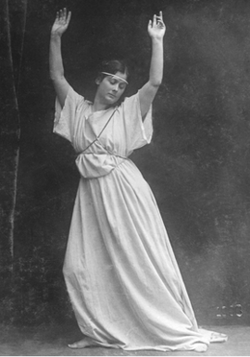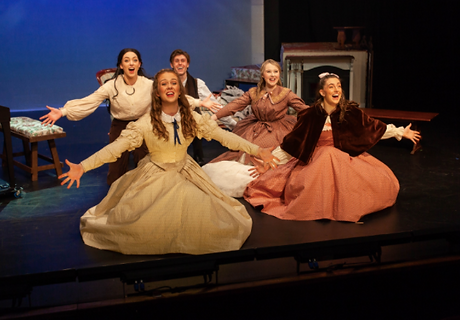THEATRE AND DANCE
EMILY CONEYBEARE
Throughout the 20th century, women have used theatre and dance as forms of expression, protest, and liberation. The evolution of feminist theatre from the 1970s to now has expanded to include more diverse identities and women of color and queer women have created their own art forms. An awareness of intersectionality for women in performance and the gender conventions, sexuality, and performance in society that surround them has complicated notions of women in theatre and dance, and also made these performances unique and complex. Disabled women, Black women, Indigenous women, queer women and many other women of marginalized idenities have used theatre and dance to find themselves and explore their unique identities. Over time, the acceptance of Western women asserting their own identities in theatre and dance has increased with overall gender equality, but the negative associations with women performers and an emphasis on “femininity” continues today. Women are underrepresented as directors, playwrights, set designers, and producers, but continue to make their way in the industry today.
DANCE
“ Feminism provides a way of looking at the world, a lens through which to consider how power circulates around the axis of not just gender, but of sexuality, race, and class.” (Croft)
Dance is a means of appropriating and activating sociocultural space. (Bradshaw, Herzogenrath)
Dance can also be a way of making political statements very physical and tangible
Rejecting institutional authority through formalist artistic experimentation
Isadora Duncan (1877–1927) [pictured left] is widely received as the founding mother of modern dance.
She said, “if my Art is symbolic of any one thing, it is symbolic of the freedom of woman and her emancipation from the hidebound conventions that are the warp and woof of New England puritanism.” (Mills, Lucas)
“My underlying assumption, for which I sought verification in manifold performances, is that human beings are equal and, at times, when there are political barriers for expression of that equality through words, human beings use their bodies to perform that equality.” - Martha Graham [pictured right]
Graham did not see herself as a feminist and yet created a strong legacy of strong women in her company and the dance world in general. (Mills, Lucas)
“The utilization of dance to protest inequality shows us the injustice and inequality in the world that has divested the dancer from all her property.” (Mills, Lucas)
Martha Graham Dance Company performing Martha Graham’s “Dark Meadow Suite”
 |  |
|---|
Dance reveals the unique identity of the dancer, even outside the West and especially in oppressive environments, for example in the case of:
“Even if not intentionally, in dancing, the dancer may change the way others see her; she may appear differently to her non- dancing self.” (Mills)
The Lindy Hop provided a means of escape, freedom, and rebellion for Black, working-class women during the swing era. (Unruh)
Jazz culture held social power for Black, working-class women
Because of expectations for the Black female body, Black, working-class women who danced the Lindy Hop were rebelling against their White employers and the Black bourgeoisie and the older generation
reclaiming their bodies for pleasure rather than wage labor.
The power of the Lindy Hop and Black dance illustrate the importance of counter-hegemonic cultural practices to African Americans, particularly before the Civil Rights Movement.
The social steps achieved on the dance floor “laid the groundwork for postwar cultural and political expression” (Caponi-Tabery xv)
“ Even in the face of tremendous adversity, it evinces an affirmation and celebration of life.…[B]lack dance is a source of energy, joy, and inspiration; a spiritual antidote to oppression” (Unruh 23-24).
Indigenous choreographers use contemporary dance practices to articulate Indigenous histories (Shea Murphy)
In Evening in Paris, Tr'ondek Hwech'in (Han) First Nations choreographer Michelle Olson, investigates the lives and careers of Penobscot cabaret dancer Molly Spotted Elk, of herself, and of her aunt and grandmother.
Contemporary dance-making practices are part of an Indigenous methodology engaged to admit ways of knowing that have been muted through colonization. (Shea Murphy)
Contemporary Indigenous performance provokes attention to embodied histories that have been taken away through a lack of documentation of indigenous communities
This focus on oral and performance traditions has long been a core of Indigenous studies
Contemporary Native artists are challenged by stereotypes of Native art
“Funding for individual Native artists is most often available for the traditional art forms and cultural practices that are being revitalized … contemporary Native artists must compete for the same scarce funds that are available to the gigantic pool of individual US artists.” (Ford Foundation 2010: 36) (Shea Murphy)
https://www.youtube.com/watch?v=ntotE7FRDbA
“Evening in Paris (Choreographed by Michelle Olson, directed by Muriel Miguel) Inspired by the remarkable life of Molly Spotted Elk and the lives of our grandmothers, this dance/theatre piece uncovers and honors the complexity of Aboriginal womens experience.”
Feminist Dance criticism is it’s own unique field, making a point to acknowledge a female artist's labor and physical choices to emphasize a woman’s artistic agency. (Croft)
Feminist dance criticism has two central tenets.
It must recognize the larger normative codes that structure critical reception of dance, including, but not limited to, those related to gender and sexuality.
It must examine the potential action of women in these systems, who, through performance, demonstrate that gender is not an essential, stable identity, but instead, in Judith Butler's now iconic terminology, is a “stylized repetition of acts.” (Croft)
Putting scholarly writing about gender, sexuality, and ballet in direct conversation with ballet's gendered conventions can help to make it clear to the audience the societal expectations surrounding the actual dancing. (Croft)
Christopher Wheeldon’s "After the Rain Pas de Deux," performed by Linda Celeste Sims and Glenn Allen Sims of Alvin Ailey Dance Theatre, 2014
https://www.youtube.com/watch?v=oIuFucW6vgw
Tiler Peck and Tyler Angle perform Christopher Wheeldon's "This Bitter Earth" at Dance Against Cancer in 2015.
THEATRE
Women have used collective creation to protest and create their own spaces.
Feminist theatre is defined by Susan Bassnett and Tracy C. Davis in “Gender in Performance as “political theatre oriented toward change, produced by women with feminist concerns.” (Bassnet and Davis)
Women’s history in the theatre is still fertile ground for excavation. (Engle)
1940s Black working class women used theatre to express their views on unionizing and strengthened interracial worker solidarity


Women war workers
“They enthusiastically participated in performances and cultural programs that reflected their pro-labor sentiment, celebrated their artistry, and strengthened interracial worker solidarity by foregrounding shared political interests.” (Ervin)
“Black women unionists opposed the historical narratives of worker theater that drew upon Old South nostalgia and failed to account for their particular economic experiences.” (Ervin)
Their productions dealt with issues such as Native American life and colonial America, the American Revolution, slavery, the railroad and Pullman strikes, and the Jazz Era.
The play openly dealt with racial prejudice among white workers and called for interracial working-class unity.
"For black subjects in diaspora, creation is always already collective, and creation is always already culturally rooted," (Syssoyeva, Proudfit)
Much of the discourse surrounding collective creation has a Western bias that understands creation as singular, leaving out many female collective-creation practitioners of color.
Women have always participated in theatre and performance, but feminist theatre is a more modern art form.
By 1968, the feminist movement was recognizing that public demonstrations were more effective for advancing feminist discouse than private group discussion sessions, leading to the establishment of some of the early feminist theatres. (Scott)
A diverse theatre movement allowed for the development of splinter groups concentrating on women’s issues.
One of these early feminist theatre companies was Nightwood Theatre in Toronto, home to women playwrights, directors, and actors
Nightwood can be examined as something of a microcosm of developments in feminist theatre and the production of women’s work. (Scott)
“Over the years, the company has presented itself as a producer of new works by women; as a provider of opportunities for women theatre artists; and as an inclusive theatre company committed to producing work by women of colour” (Scott)
Performing the work of women theatre makers (that is, women who wrote, translated, published, commissioned, produced and performed in plays) also continues to be a political act (Schafer)
THE TRANSFORMATIONS PROJECT: Young Park, Wy Joung Kou, Jody Chan of Raging Asian Womxn Taiko Drummers at Nightwood Theatre Toronto
Disabled women's collectives are spaces to explore difference, agency, and interdependence. (Syosseva, Proudfit)
"membership in the world of theatre and dance (conservative or liberal, feminist or mixed) is controlled by an unexamined standard of equality built on the intact body," there could be much to be gained by "paying attention to difference" and by "de-stigmatiz[ing] dependence and weakness" (Syosseva, Proudfit 314).
Drag Kings, Sluts & Goddesses, a Boston-based theatre production run by lesbian and bi women of color utilizes music, dance, and performance for a cabaret that mixes message with "lesbian come-hither" art. (Katz)
Performers of every size depict key issues for sapphic women such as economic insecurity and lesbian domestic violence (Katz)
These performances celebrate the aspects of queerness that fueled the original movement.
"The radical icons of our liberation are being erased -- the drag queens, the stone butches, the trannie boyz and girlz. In `Decadence' I say that if the nuclear family is what morality is, then I don't want to be moral." (Katz)
The theatre company focuses on real life experiences, “not projected through the lens of male eyes."
Built around socially-conscious themes, the uniqueness of this type of theatre is in the sexual self-confidence of the performers and a butch-femme visual language.



